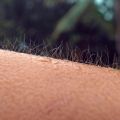Generations of macaques have used stone tools to open their oysters and nuts
9 June 2016
A new study looks into the history of stone tools used by wild macaques in coastal Thailand. It finds they have been using them for decades…and possibly thousands of years… to crack open shellfish and nuts.While there have been several studies observing living non-human primates, this is the first report into the archaeological evidence of tool use by Old World monkeys. The research, led by the Primate Archaeology Research Group at the University of Oxford, opens up novel research possibilities. The paper, published in the Journal of Human Evolution, says this is just the first step in finding out how their behaviour compares with that of early humans living in similar environments.
From a distance in boats off the coast, researchers spent hundreds of hours watching how groups of macaques in the marine national park on Piak Nam Yai Island selected stones as tools to crush marine snails, nuts and crabs. While the tide was out, the macaques broke open oysters attached to large boulders. They dislodged the top half of the shell using their crushing tool and then scooped out the meat with their fingers from the remaining part still attached to the rock. The researchers also found that once a macaque had a good stone fit for the job, they would keep it to crack open other shells or nuts before dropping it. Once the job was done, the macaques often discarded their tools around the same boulders where they had enjoyed their meal.
When the macaques had left the shore, the research team went on land to closely examine the tools for marks. They found features such as pitting on the flat side, or crushing and fracture marks on the narrow ends of the stones. They also excavated the area beneath a prominent boulder for evidence of discarded stone tools used by previous generations of macaques. Having identified the tell-tale marks of food processing, the researchers spotted ten tools in the oldest archaeological layer, at 65 cm below the surface. The researchers were limited in how far down they could dig given the high tides that inundated the boulder twice a day. They indirectly dated the excavated tools as between 10 and 50 years old, through obtaining radiocarbon dates for oyster shell debris found in the same undisturbed archaeological layer.
Lead author Dr Michael Haslam, from the School of Archaeology at the University of Oxford and leader of the Primate Archaeology (Primarch) project, said: ‘We find that primates with much smaller brains than humans have innovative ways of exploiting the food sources available to them. Macaques in the forests on the island come down to the shore when the tide is out to forage, and use stones as tools in order to break open shells and hard nut casings to access the food inside.
‘What we don’t have at the moment is a body of archaeological evidence to compare the evolutionary behaviour of other primates with our own. Uncovering the history of the macaques’ foraging behaviour is a first step. As we build up a fuller picture of their evolutionary history, we will start to identify the similarities and differences in human behaviour and that of other primates.’
In previous research led by Dr Haslam – a paper published in May 2016 in the Journal of Archaeological Science: Reports – a team also observed the tool-carrying distances of the macaques on Piak Nam Yai Island. They found the monkeys typically moved their tools a metre or less from where they picked them up, although the longest distance that a macaque carried a tool was 87.6m. On average they ate nine oysters at a time, moving short distances with the same tool. However, in one case they observed a hungry macaque eat 63 oysters in a row, using the same stone tool to cleave the shells open.
For more information, contact the University of Oxford News Office on +44 (0)1865 280534 or email: [email protected]
Notes for Editors:
- There are images of macaques using stone tools to open shellfish, available to media on request. The images should be credited to Michael Haslam.
- The paper, Archaeological excavation of wild macaque stone tools, is by Michael Haslam, Lydia Luncz, Alejandra Pascual-Garrido, Tiago Falotico, Suchinda Malaivijitnond and Michael Gumert. The research team involved were from the University of Oxford, Chulalongkorn University, Bangkok; and Nanyang Technological University, Singapore.
- The research is funded by the European Research Council.
- The Primate Archaeology Project led by Dr Haslam runs archaeology work at various sites around the world. For the macaques, the PAP is working in cooperation with a nine-year running programme on macaque tool use in Thailand, led by Michael Gumert of Nanyang Technological University, Singapore and Chulalongkorn University, Thailand –with researcher Suchinda Malaivijitnond.
 Researchers find oldest undisputed evidence of Earth’s magnetic field
Researchers find oldest undisputed evidence of Earth’s magnetic field
 Honorary degree recipients for 2024 announced
Honorary degree recipients for 2024 announced
 Vice-Chancellor's innovative cross-curricular programme celebrated
Vice-Chancellor's innovative cross-curricular programme celebrated
 New database sheds light on violence in Greek detention facilities
New database sheds light on violence in Greek detention facilities
 New trial using skin patches as an ‘early warning system’ to spot lung transplant rejection
New trial using skin patches as an ‘early warning system’ to spot lung transplant rejection